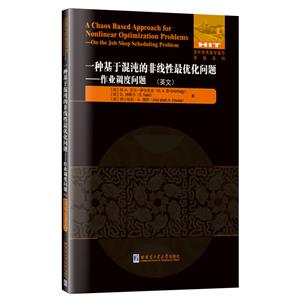一種基于混沌的非線性最優化問題——作業調度問題(英文) 版權信息
- ISBN:9787576706789
- 條形碼:9787576706789 ; 978-7-5767-0678-9
- 裝幀:平裝-膠訂
- 冊數:暫無
- 重量:暫無
- 所屬分類:>>
一種基于混沌的非線性最優化問題——作業調度問題(英文) 內容簡介
廣博,包括應用領域的知識,對*有意義的數學研究具有重大價值.對于那些有能力學習各種課程的學生,重要的是把他所能吸收的知識全部用來構成關于數學的完整圖畫.本書就是一部從國外引進的很好的踐行這一論斷的英文數學專著。本書包含六章:**章是關于很優化主題的一個綜述,我們提出了很優化問題的數學模型,然后介紹很優化問題的分類.本章中我們也提出了解很優化問題的很優化方法。第二章致力于介紹遺傳算法的工作原理,并解釋遺傳算法是如何應用到解很優化問題中的.我們還介紹了遺傳算法參數和使用遺傳算法解很優化問題的優勢和劣勢。第三章提出解非線性很優化問題的一個新算法.該算法是很優化方法之一(遺傳算法)與混沌理論的結合,以提高性能并獲得很好解決方案.它是一個為解決非線性很優化問題而結合了遺傳搜索特征和混沌搜索特征的新算法.為了說明找到很優解的成功結果,已經測試了各種基準問題。第四章提出了作業調度問題的結構,然后介紹了作業調度問題的公式化.我們也展示了作業調度問題的復雜性.*后,我們介紹了求解作業調度的方法。第五章旨在實現我們解作業調度問題的新方法,并解釋它的細節,各種基準問題的實驗結果的測試也會被討論.我們通過將結果與另一種方法進行比較,來表明我們的方法的可靠性及其解決作業調度問題的能力。第六章為結論,以及給未來研究者的幾點建議。
一種基于混沌的非線性最優化問題——作業調度問題(英文) 目錄
List of Figures
List of Tables
Abstract
CHAPTER 1: A Survey on Related Topoes
1.1 Introduction
1.2 Mathematical Model of Optimization Problems
1.3 Classification of optimization problems
1.3.1 Classification based on existence of constraints
1.3.2 Classification based on nature of the design variables
1.3.3 Classification based on physical structure of the problem
1.3.4 Classification based on nature of the equations involved
1.3.5 Classification based on permissible values of the design variables
1.3.6 Classification based on deterministic nature of the variables
1.3.7 Classification based on separability of the functions
1.3.8 Classification based on number of the objective functions
1.4 Optimization Techniques
1.4.1 Classical Optimization Techniques
1.4.1.1 Nonlinear Programming
1.4.2 Advanced Techniques
1.4.2.1 Genetic algorithm (GA)
1.4.2.2 Simulated annealing (SA)
1.4.2.3 Neural network optimization
1.4.2.4 Tabu search (TS)
1.4.2.5 Ant colony optimization (ACO)
1.4.2.6 Particle swarm optimization (PSO)
1.4.2.7 Harmony search (HS)
1.4.2.8 Artificial bee colony (ABC)
CHAPTER 2: Genetic Algorithm
2.1 Introduction
2.2 Working Principle of GA
2.3 Genetic algorithm procedure for optimization problems
2.3.1 Encoding
2.3.2 Initial Population
2.3.3 Evaluation
2.3.4 Create new population
2.3.4.1 Selection
2.3.4.2 Crossover
2.3.4.3 Mutation
2.3.5 Repair
2.3.6 Migration
2.3.7 Termination Test
2.4 Genetic algorithm Parameters
2.4.1 Crossover probability
2.4.2 Mutation probability(Pro)
2.4.3 Population Size
2.5 Advantages and disadvantages of GA
2.5.1 Advantages of GA
2.5.2 Disadvantages of GA
CHAPTER 3: A Chaos-based Evolutionary Algorithm for General Nonlinear Programming Problems
3.1 Introduction
3.2 Chaos Theory
3.3 Chaotic maps
3.4 The proposed algorithm
3.4.1 Phase I: GA
3.4.2 Phase II : Chaotic local search
3.5 Experimental results
3.5.1 Test function
3.5.1.1 Unconstrained benchmark problems
3.5.1.2 Constrained benchmark problems
3.5.2 Performance Analysis Using Different Chaotic Maps
3.5.3 Performance Analysis using logistic map
3.5.4 Speed Convergence analysis
3.6 Conclusion
CHAPTER 4: Job Shop Scheduling Problems
4.1 Introduction
4.2 Scheduling Problem Types
4.3 Job shop scheduling problem structure
4.4 Job shop scheduling problem formulation
4.4.1 Mathematical representation of JSSP
4.4.2 Disjunctive graph
4.4.3 Gantt-Chart
4.5 Complexity of JSSP
4.6 Job shop scheduling solving techniques
4.6.1 Exact techniques
4.6.1.1 Mathematical techniques
4.6.1.2 Enumerative techniques
4.6.1.3 Decomposition strategies
4.6.2 Approximate techniques
4.6.2.1 Constructive Methods
4.6.2.2 Insertion Algorithms
4.6.2.3 Evolutionary Methods
4.6.2.4 Local Search Techniques
CHAPTER 5: Hybrid Genetic Algorithm for Job Shop Scheduling Problems
5.1 Introduction
5.2 The proposed algorithm (HGA)
5.2.1 Phase I: GA
5.2.2 Phase II: Local search
5.3 Experimental Results
5.3.1 Test Problems
5.3.2 Results and discnssion
5.4 Conclusion
CHAPTER 6: Conclusions and Future Work
6.1 Conclusions
6.2 Future Work
Bibliography
編輯手記
List of Tables
Abstract
CHAPTER 1: A Survey on Related Topoes
1.1 Introduction
1.2 Mathematical Model of Optimization Problems
1.3 Classification of optimization problems
1.3.1 Classification based on existence of constraints
1.3.2 Classification based on nature of the design variables
1.3.3 Classification based on physical structure of the problem
1.3.4 Classification based on nature of the equations involved
1.3.5 Classification based on permissible values of the design variables
1.3.6 Classification based on deterministic nature of the variables
1.3.7 Classification based on separability of the functions
1.3.8 Classification based on number of the objective functions
1.4 Optimization Techniques
1.4.1 Classical Optimization Techniques
1.4.1.1 Nonlinear Programming
1.4.2 Advanced Techniques
1.4.2.1 Genetic algorithm (GA)
1.4.2.2 Simulated annealing (SA)
1.4.2.3 Neural network optimization
1.4.2.4 Tabu search (TS)
1.4.2.5 Ant colony optimization (ACO)
1.4.2.6 Particle swarm optimization (PSO)
1.4.2.7 Harmony search (HS)
1.4.2.8 Artificial bee colony (ABC)
CHAPTER 2: Genetic Algorithm
2.1 Introduction
2.2 Working Principle of GA
2.3 Genetic algorithm procedure for optimization problems
2.3.1 Encoding
2.3.2 Initial Population
2.3.3 Evaluation
2.3.4 Create new population
2.3.4.1 Selection
2.3.4.2 Crossover
2.3.4.3 Mutation
2.3.5 Repair
2.3.6 Migration
2.3.7 Termination Test
2.4 Genetic algorithm Parameters
2.4.1 Crossover probability
2.4.2 Mutation probability(Pro)
2.4.3 Population Size
2.5 Advantages and disadvantages of GA
2.5.1 Advantages of GA
2.5.2 Disadvantages of GA
CHAPTER 3: A Chaos-based Evolutionary Algorithm for General Nonlinear Programming Problems
3.1 Introduction
3.2 Chaos Theory
3.3 Chaotic maps
3.4 The proposed algorithm
3.4.1 Phase I: GA
3.4.2 Phase II : Chaotic local search
3.5 Experimental results
3.5.1 Test function
3.5.1.1 Unconstrained benchmark problems
3.5.1.2 Constrained benchmark problems
3.5.2 Performance Analysis Using Different Chaotic Maps
3.5.3 Performance Analysis using logistic map
3.5.4 Speed Convergence analysis
3.6 Conclusion
CHAPTER 4: Job Shop Scheduling Problems
4.1 Introduction
4.2 Scheduling Problem Types
4.3 Job shop scheduling problem structure
4.4 Job shop scheduling problem formulation
4.4.1 Mathematical representation of JSSP
4.4.2 Disjunctive graph
4.4.3 Gantt-Chart
4.5 Complexity of JSSP
4.6 Job shop scheduling solving techniques
4.6.1 Exact techniques
4.6.1.1 Mathematical techniques
4.6.1.2 Enumerative techniques
4.6.1.3 Decomposition strategies
4.6.2 Approximate techniques
4.6.2.1 Constructive Methods
4.6.2.2 Insertion Algorithms
4.6.2.3 Evolutionary Methods
4.6.2.4 Local Search Techniques
CHAPTER 5: Hybrid Genetic Algorithm for Job Shop Scheduling Problems
5.1 Introduction
5.2 The proposed algorithm (HGA)
5.2.1 Phase I: GA
5.2.2 Phase II: Local search
5.3 Experimental Results
5.3.1 Test Problems
5.3.2 Results and discnssion
5.4 Conclusion
CHAPTER 6: Conclusions and Future Work
6.1 Conclusions
6.2 Future Work
Bibliography
編輯手記
展開全部
書友推薦
- >
我與地壇
- >
名家帶你讀魯迅:故事新編
- >
推拿
- >
姑媽的寶刀
- >
經典常談
- >
回憶愛瑪儂
- >
李白與唐代文化
- >
我從未如此眷戀人間
本類暢銷
















